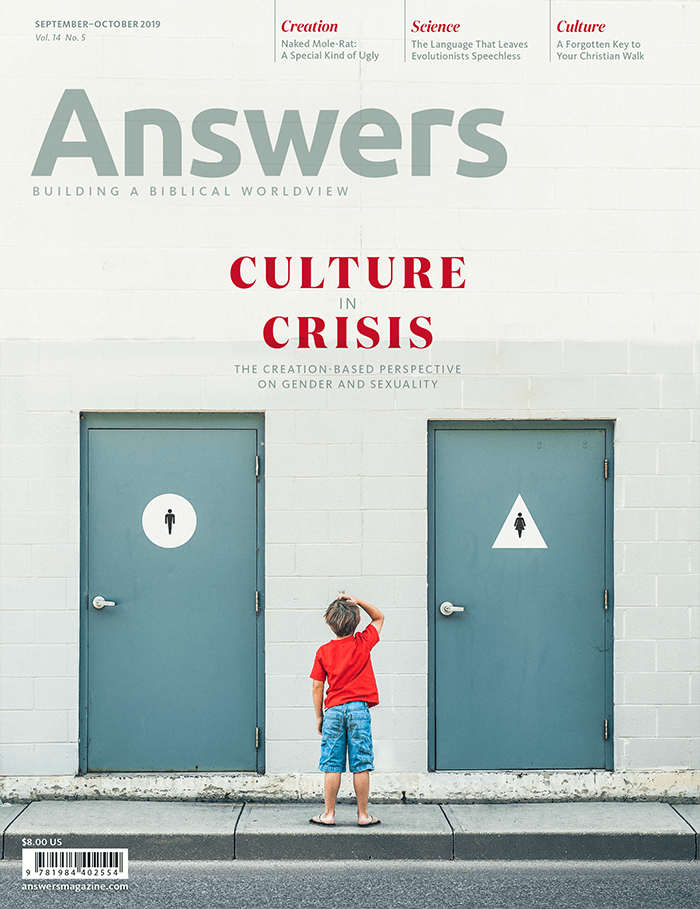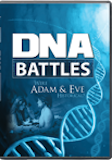The Biology of Gender
With 112 gender options, our culture is in desperate need of a basic biology lesson.
Editor’s note: This discussion contains terminology that may not be appropriate for sensitive readers and children. Parents are cautioned.
Modern society tells us that we can choose our gender, that gender is based on subjective feeling, and that gender is “fluid.” According to a blog on Tumblr,1 there are 112 genders, including the following:
- Apconsugender—a gender where you know what it isn’t, but not what it is; the gender is hiding itself from you
- Heliogender—a gender that is warm and burning
- Perigender—identifying with a gender but not as a gender
- Verangender—a gender that seems to shift/change the moment it is identified
While these so-called genders may seem absurd, they show us that people are very confused and very much in need of the truth of God’s Word and some basic biology.
Are Gender and Sex Different?
In an attempt to usurp biological fact, the sexual revolutionaries have tried to separate gender and sex by defining them as two separate aspects of a person. A recent paper on this topic stated, “Sex is a biological trait that is determined by the specific sex chromosomes. . . . Gender, on the other hand, is socially, culturally, and personally defined.”2
Another article gave a similar definition for sex and then stated, “The concept of gender . . . is meaningfully different from biological sex. Gender identity is a subjective feeling of ‘maleness’ and ‘femaleness.’”3 (Or, if you go by the Tumblr blog’s definitions of gender, maybe something else entirely!) But what do the medical experts who write the medical dictionaries say?
They continue to define gender and sex as synonymous. The current edition of Stedman’s Medical Dictionary defines gender as a “category to which an individual is assigned by self or others, on the basis of sex” (emphasis mine). Sex is defined as “the biologic character or quality that distinguishes male and female.”4
Taber’s Cyclopedic Medical Dictionary defines gender as “the sex of an individual (i.e., male or female)” and sex as “1. the characteristics that differentiate male and females in most plants and animals. 2. Gender.”5 It’s clear from a medical and scientific perspective that they are the same. Only those who desire to do what is right in their own eyes (Judges 21:25) want to make these terms distinctive in order to justify their sin.
The Word of God also does not separate gender from sex. Genesis 1:27 refers to the creation of male and female (sex), and in Genesis 2 we read of the creation of man and woman (gender) in more detail. Specific male and female pronouns (e.g., she/her, he/his) are used to link male with man and female with woman throughout the Genesis account of creation. Sex is directly connected to gender. Moreover, after God finished his creation, he declared it “very good” (Genesis 1:31). So God’s good design is for only two genders/sexes, and this design is confirmed by our biology.
Are There Two Distinct Genders/Sexes?
The normal complement of human chromosomes is 23 pairs—22 pairs of autosomes and one pair of sex chromosomes. Females have two X chromosomes, and males have one X and one Y chromosome. The sex-determining region on the Y chromosome (SRY) is a gene that inhibits female anatomical growth and induces the formation of male anatomy about 6–8 weeks after fertilization in the womb. This is not to say that the baby does not have a gender/sex up to this point but rather that it is not apparent from an outside appearance until that point.
Most people are aware of the distinct anatomical differences between males and females and how those differences make it possible for men and women to procreate. However, there are many physiological differences as well. Most of these result from differences in sex hormones (e.g., testosterone and estrogen/progesterone) and their levels, which are determined by the differences in sex chromosomes.
Females convert more energy to stored fat, and males convert more to muscle. While many women may not like fat, it’s directly related to fertility, so there’s a good reason for fat! Males have more red blood cells and clotting factors; and females have more white blood cells, produce antibodies quicker, and get sick less often. This means that man flu may be a real thing! These distinct, designed physiological characteristics make sense because men tend to be more involved in activities that involve taking risks, hunting, protection, and war; women are more involved with childrearing and are active in social groups.
The distinctive anatomical and physiological differences between males and females have taken a front row seat in the current debate about transgender men (men identifying as women) participating in women’s sports competitions. Basic biology cannot be denied because men have larger hearts, larger lungs, and more muscle mass (just to name a few differences) that give them a distinct advantage over women. No matter how hard women train, they likely will not be able to beat men. So including transgender men makes these sport competitions very unfair to women. The sexual revolution will now have to figure out how to deal with the outcomes of their wrong thinking.
In agreement with biology, the Bible shows that God created two distinct genders/sexes. In Genesis 1:27 God creates male and female in his image. In Genesis 2:23, Adam expresses their similarities but also their differences by giving the female a different name—woman.
Real Differences
Males and females have numerous physical differences beyond just reproductive anatomy. Here’s a small sample:

What About Gender/Sex in Animals?
According to evolutionary ideas, humans are just another animal, so the biology and behaviors of the animal kingdom are sometimes used to justify the same among human beings. The sexual revolutionaries reason that if something is normal in animals then it should be considered normal in humans too.
There are two types of hermaphroditism (being both male and female) among animals—traditional and sequential. Traditional hermaphroditism is common among snails, slugs, worms, and fish. In this case, the organism has both male and female anatomical parts and/or both sperm and eggs. This God-given design helps organisms in areas where mates may not be readily accessible so the organism can continue to reproduce.
Sequential hermaphroditism describes an organism (such as a fish, snail, crustacean, or frog) that is born one sex but transitions to the opposite sex at some point. For example, the female in a pair of reef fish dies. Rather than the male leaving the safety of the reef to find another female, he waits on the reef. If a male comes along, one of them will transition to a female so they can mate. This is not based on some “feeling” to become the opposite sex but rather a biological design that God has built into them as a survival strategy to help them in a fallen world.
Some animals (such as snakes, lizards, fish, and birds) will act like the opposite sex to gain a temporary advantage. This results in reduced competition, better mating opportunities, and better access to territories. Once it gains the advantage, the animal will essentially “stop the act” and behave like its born sex. This is another example of built-in design aiding survival in our current world suffering the effects of the fall.
Is it really wise to make the argument that what is normal in animals should be normal in humans too? Animals eat each other, kill their mates and young, and exhibit violent behavior toward each other. To be consistent, the sexual revolutionaries would have to admit that these behaviors should be viewed as normal in humans too. But human beings are different from animals because we are made in the image of God (Genesis 1:26–27) and we were given dominion over the animals (Genesis 1:28).
What About Gender/Sex Abnormalities?
People often use gender/sex abnormalities to argue that gender and sex are distinct aspects of a person. They say that a person can be genetically one sex while their outside appearance can be the opposite sex. We need to realize these abnormalities do exist but only because we live in a fallen world. We should never argue from the abnormal and rare for the normal and common. Let’s take a look at several of the most common abnormalities, but keep in mind that these affect less than 0.1% of the population.
- Hermaphroditism or intersex describes a child born with both ovarian and testicular tissue. However, in the vast majority of these cases, the child is genetically either XX (female) or XY (male), not both. The underlying cause for the physical abnormality is unknown.
- Congenital adrenal hyperplasia results from insufficient or excessive sex steroids, resulting in an outward appearance that may be opposite of the underlying chromosomes; but again, the child is genetically only XX or only XY.
- Androgen insensitivity syndrome occurs in genetic males (XY) whose tissues are unresponsive to male hormones, so they outwardly appear anatomically female. (Normal males and females have both testosterone and estrogen/progesterone, but the levels of the hormones and tissue responsiveness vary depending on whether they are male or female.)
- Turner’s syndrome occurs in females that have only one X chromosome (XO). Their ovaries typically degenerate before birth, so they do not develop female secondary sex characteristics and are infertile.
- Klinefelter’s syndrome occurs in males that have two X chromosomes and one Y chromosome (XXY). They develop reduced male secondary sex characteristics and are also typically infertile.
- XX male or XY female occurs very rarely (less than .005% of live births). This results from either a translocation (movement) of the SRY gene to an X chromosome or a mutation in the SRY gene, respectively. These individuals typically do not display secondary sex characteristics and are infertile. Since the SRY gene determines male anatomy and “maleness,” if it is present, then the individual is male (even if the person has two X chromosomes); and if not, then the individual is female (even if the person has an X and Y chromosome).
In all these cases, we see that individuals are either male or female based on their sex chromosomes (or portions thereof), so there are only two genders/sexes. And every person born is either one or the other. Many times parents and doctors may not even be aware that children have these disorders at birth. These disorders present difficult situations in a sin-cursed world, and parents, children, and doctors need support and compassion as they face challenging decisions.
It should be noted that studies of individuals with gender/sex abnormalities have shown that they typically do not struggle with gender identity or homosexuality (less than 1%).6 So even in a situation in which there might be a legitimate underlying biological reason for confusion about gender or sexual attraction, there doesn’t appear to be any connection between biology and those struggles.
Biology and God’s Word are clear—there are only two genders/sexes.
Biology and God’s Word are clear—there are only two genders/sexes. Regardless of what people feel, reality is that they are either male or female. Ever since Adam’s rebellion, all of us are born sinners (Psalm 51:5), and all struggle with sin, but we must remember, “No temptation has overtaken you that is not common to man. God is faithful, and he will not let you be tempted beyond your ability but with the temptation he will also provide a way of escape, that you may be able to endure it” (1 Corinthians 10:13). For those struggling with gender identity, there is true hope—the same hope of everyone else in this fallen world—the gospel of Jesus Christ.
Answers Magazine
September–October 2019
The fact that the human race is divided into two biological groups, male and female, is unquestionable. So how is it possible that people question this distinction?
Browse Issue SubscribeFootnotes
- “How Many Genders Are There in 2019?,” https://dudeasks.com/how-many-genders-are-there-in-2019/.
- Krista Conger, “Of Mice, Men and Women,” Sex, Gender and Medicine, spring 2017, https://stanmed.stanford.edu/2017spring/how-sex-and-gender-which-are-not-the-same-thing-influence-our-health.html.
- Jesse Bering, “The Third Gender,” Scientific American (October 1, 2012), https://www.scientificamerican.com/article/the-third-gender-2012-10-23/#googDisableSync.
- Stedman’s Medical Dictionary, 28th ed. (Lippincott Williams & Wilkins, 2006).
- Taber’s Cyclopedic Medical Dictionary, 20th ed. (F. A. Davis Company, 2005).
- Ken C. Pang et al., “Molecular Karyotyping in Children and Adolescents with Gender Dysphoria,” Transgender Health 3.1 (2018):147–153.
Recommended Resources

Answers in Genesis is an apologetics ministry, dedicated to helping Christians defend their faith and proclaim the good news of Jesus Christ.
- Customer Service 800.778.3390
- © 2024 Answers in Genesis






